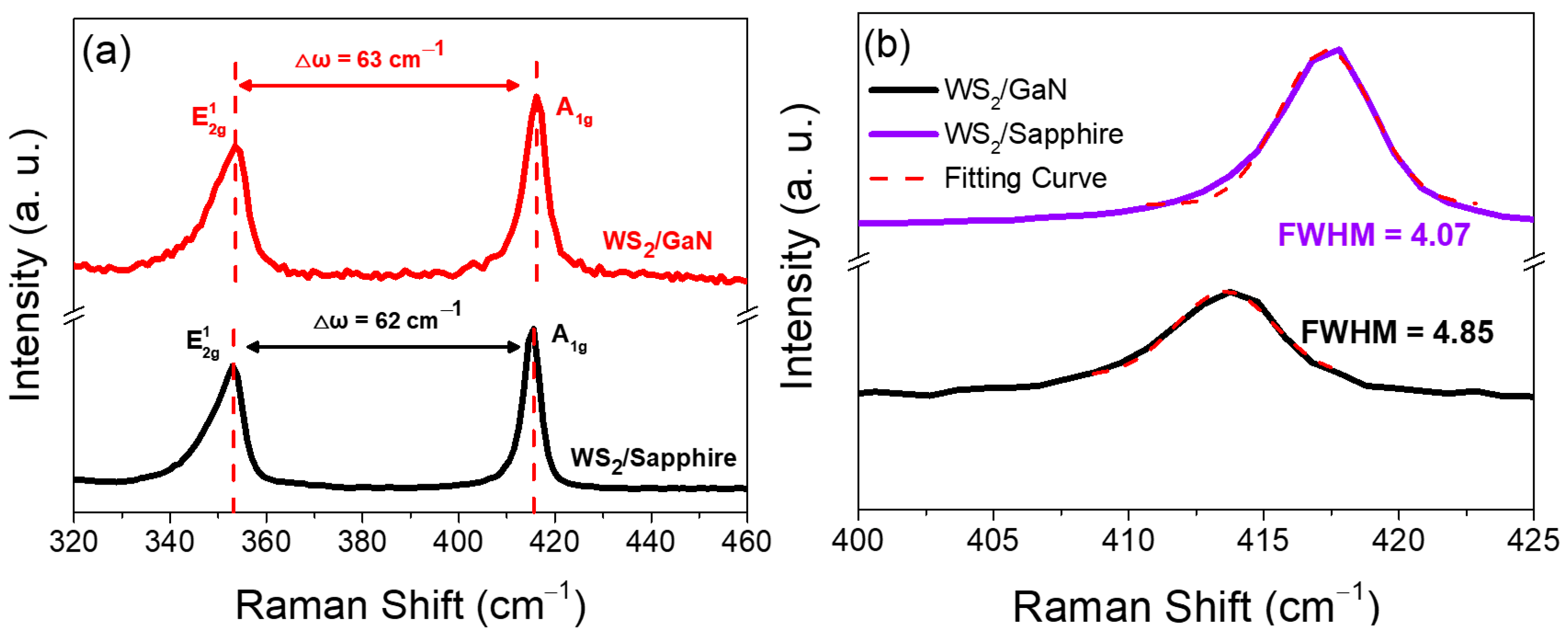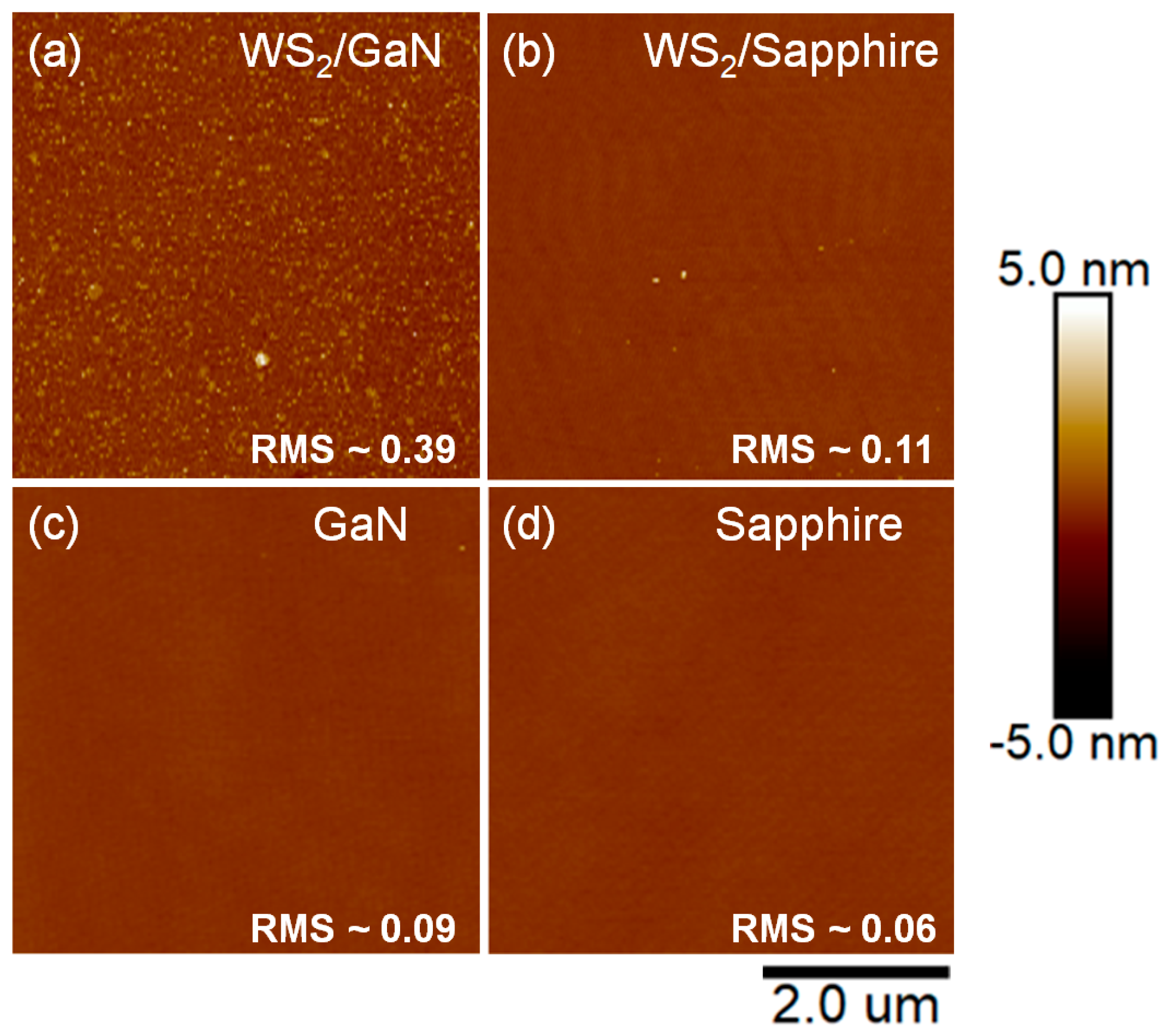The Role of GaN in the Heterostructure WS2/GaN for SERS Applications
Abstract
1. Introduction
2. Materials and Methods
2.1. Fabrication of WS2/GaN Heterostructure
2.2. Preparation of R6G Molecules
2.3. Characterizations
3. Results and Discussion
4. Conclusions
Supplementary Materials
Author Contributions
Funding
Institutional Review Board Statement
Informed Consent Statement
Data Availability Statement
Acknowledgments
Conflicts of Interest
References
- Santhoshkumar, S.; Murugan, E. Rationally designed SERS AgNPs/GO/g-CN nanohybrids to detect methylene blue and Hg2+ ions in aqueous solution. Appl. Surf. Sci. 2021, 533, 149544. [Google Scholar] [CrossRef]
- Tzeng, Y.; Lin, B.-Y. Silver SERS Adenine Sensors with a Very Low Detection Limit. Biosensors 2020, 10, 53. [Google Scholar] [CrossRef]
- Lai, H.; Li, G.; Xu, F.; Zhang, Z. Metal–organic frameworks: Opportunities and challenges for surface-enhanced Raman scattering–A review. J. Mater. Chem. C 2020, 8, 2952–2963. [Google Scholar] [CrossRef]
- Guo, J.; Zeng, F.; Guo, J.; Ma, X. Preparation and application of microfluidic SERS substrate: Challenges and future perspectives. J. Mater. Sci. Technol. 2020, 15, 96–103. [Google Scholar] [CrossRef]
- Liu, Y.; Ma, H.; Han, X.X.; Zhao, B. Metal–semiconductor heterostructures for surface-enhanced Raman scattering: Synergistic contribution of plasmons and charge transfer. Mater. Horiz. 2021, 8, 370–382. [Google Scholar] [CrossRef]
- Alhmoud, H.; Brodoceanu, D.; Elnathan, R.; Kraus, T.; Voelcker, N.H. A MACEing silicon: Towards single-step etching of defined porous nanostructures for biomedicine. Prog. Mater. Sci. 2021, 116, 100636. [Google Scholar] [CrossRef]
- Freeman, R.G.; Grabar, K.C.; Allison, K.J.; Bright, R.M.; Davis, J.A.; Guthrie, A.P.; Hommer, M.B.; Jackson, M.A.; Smith, P.C.; Walter, D.G.; et al. Self-Assembled Metal Colloid Monolayers: An Approach to SERS Substrates. Science 1995, 267, 1629–1632. [Google Scholar] [CrossRef]
- Singh, J.P.; Chu, H.Y.; Abell, J.; Tripp, R.A.; Zhao, Y. Flexible and mechanical strain resistant large area SERS active substrates. Nanoscale 2012, 4, 3410–3414. [Google Scholar] [CrossRef]
- Xia, L.; Chen, M.; Zhao, X.; Zhang, Z.; Xia, J.; Xu, H.; Sun, M. Visualized method of chemical enhancement mechanism on SERS and TERS. J. Raman Spectrosc. 2014, 45, 533–540. [Google Scholar] [CrossRef]
- Chen, R.; Jensen, L. Interpreting the chemical mechanism in SERS using a Raman bond model. J. Chem. Phys. 2020, 152, 024126. [Google Scholar] [CrossRef]
- Qiu, H.; Li, Z.; Gao, S.; Chen, P.; Zhang, C.; Jiang, S.; Li, H. Large-area MoS2 thin layers directly synthesized on Pyramid-Si substrate for surface-enhanced Raman scattering. RSC Adv. 2015, 5, 83899–83905. [Google Scholar] [CrossRef]
- Dai, Z.; Xiao, X.; Wu, W.; Zhang, Y.; Liao, L.; Guo, S.; Jiang, C. Plasmon-driven reaction controlled by the number of graphene layers and localized surface plasmon distribution during optical excitation. Light Sci. Appl. 2015, 4, e342–e348. [Google Scholar] [CrossRef]
- Ernandes, C.; Khalil, L.; Almabrouk, H.; Pierucci, D.; Zheng, B.; Avila, J.; Dudin, P.; Chaste, J.; Oehler, F.; Pala, M.; et al. Indirect to direct band gap crossover in two–dimensional WS2(1−x)Se2x alloys. NPJ 2D Mater. Appl. 2021, 5, 7. [Google Scholar] [CrossRef]
- Wang, Y.; Tutuc, E.; Sohier, T.; Watanabe, K.; Taniguchi, T.; Verstraete, M.J. Electron mobility in monolayer WS2 encapsulated in hexagonal boron–nitride. Appl. Phys. Lett. 2021, 118, 102105. [Google Scholar] [CrossRef]
- Zhang, D.; Xiong, Y.; Chai, J.; Liu, T.; Ba, X.; Cheng, J.; Ullah, S.; Zheng, G.; Yan, M.; Cao, M. Synergetic dielectric loss and magnetic loss towards superior microwave absorption through hybridization of few–layer WS2 nanosheets with NiO nanoparticles. Sci. Bull. 2020, 65, 138–146. [Google Scholar] [CrossRef]
- Zhang, X.; Dong, Q.; Li, Z.; Jing, X.; Liu, R.; Liu, B.; Zhao, T.; Lin, T.; Li, Q.; Liu, B. Significant pressure–induced enhancement of photoelectric properties of WS2 in the near–infrared region. Mater. Res. Lett. 2022, 10, 547–555. [Google Scholar] [CrossRef]
- Ghopry, S.A.; Alamri, M.A.; Goul, R.; Sakidja, R.; Wu, J.Z. Extraordinary Sensitivity of Surface–Enhanced Raman Spectroscopy of Molecules on MoS2 (WS2) Nanodomes/Graphene van der Waals Heterostructure Substrates. Adv. Optical Mater. 2019, 7, 1801249. [Google Scholar] [CrossRef]
- Ghopry, S.A.; Alamri, M.; Goul, R.; Cook, B.; Sadeghi, S.M.; Gutha, R.R.; Sakidja, R.; Wu, J.Z. Au Nanoparticle/WS2 Nanodome/Graphene van der Waals Heterostructure Substrates for Surface–Enhanced Raman Spectroscopy. ACS Appl. Nano Mater. 2020, 3, 2354–2363. [Google Scholar] [CrossRef]
- Song, Y.; Huang, H.C.; Lu, W.; Li, N.; Su, J.; Cheng, S.B.; Lai, Y.; Chen, J.; Zhan, J. Ag@WS2 quantum dots for Surface Enhanced Raman Spectroscopy: Enhanced charge transfer induced highly sensitive detection of thiram from honey and beverages. Food Chem. 2022, 344, 128570. [Google Scholar] [CrossRef]
- Fu, S.; Fossé, I.d.; Jia, X.; Xu, J.; Yu, X.; Zhang, H.; Zheng, W.; Krasel, S.; Chen, Z.; Wang, Z.M.; et al. Long–lived charge separation following pump–wavelength–dependent ultrafast charge transfer in graphene/WS2 heterostructures. Sci. Adv. 2021, 7, eabd9061. [Google Scholar] [CrossRef]
- Shin, Y.; Kim, J.; Jang, Y.; Ko, E.; Lee, N.S.; Yoon, S.; Kim, M.H. Vertically–Oriented WS2 Nanosheets with a Few Layers and Its Raman Enhancements. Nanomaterials 2020, 10, 1847. [Google Scholar] [CrossRef]
- Berkdemir, A.; Gutiérrez, H.R.; Botello–Méndez, A.R.; Perea-López, N.; Elías, L.A.; Chia, C.I.; Wang, B.; Crespi, V.H.; López-Urías, F.; Charlier, J.-C.; et al. Identification of individual and few layers of WS2 using Raman Spectroscopy. Sci. Rep. 2013, 3, 1755. [Google Scholar] [CrossRef]
- Zheng, D.; Dong, X.; Lu, J.; Niu, Y.; Wang, H. Ultrafast and hypersensitized detection based on van der Waals connection in two-dimensional WS2/Si structure. Appl. Surf. Sci. 2022, 574, 151662. [Google Scholar] [CrossRef]
- Sinha, S.; Arora, S.K.; Sathe, V. Temperature Dependent Phononic Response of Liquid Phase Exfoliated Few Layered WS2 Nanosheets. AIP Conf. Proc. 2019, 2115, 030197. [Google Scholar]
- Zhang, Y.; Zhang, Y.; Ji, Q.; Ju, J.; Yuan, H.; Shi, J.; Gao, T.; Ma, D.; Liu, M.; Chen, Y.; et al. Controlled Growth of High–Quality Monolayer WS2 Layers on Sapphire and Imaging Its Grain Boundary. ACS Nano 2013, 7, 8963–8971. [Google Scholar] [CrossRef]
- Qiao, S.; Yang, H.; Bai, Z.; Peng, G.; Zhang, X. Thickness–dependent structural and electrical properties of WS2 nanosheets obtained via the ALD–grown WO3 sulfurization technique as a channel material for field–effect transistors. ACS Omega 2021, 6, 34429–34437. [Google Scholar]
- McCreary, A.; Berkdemir, A.; Wang, J.; Nguyen, M.A.; Elías, A.L.; Perea-López, N.; Fujisawa, K.; Kabius, B.; Carozo, V.; Cullen, D.A.; et al. Distinct photoluminescence and Raman spectroscopy signatures for identifying highly crystalline WS2 monolayers produced by different growth methods. J. Mater. Res. 2016, 31, 931–944. [Google Scholar] [CrossRef]
- Henning, A.; Bartl, J.D.; Zeidler, A.; Qian, S.; Bienek, O.; Jiang, C.-M.; Paulus, C.; Rieger, B.; Stutzmann, M.; Sharp, I.D. Aluminum Oxide at the Monolayer Limit via Oxidant–Free Plasma–Assisted Atomic Layer Deposition on GaN. Adv. Funct. Mater. 2021, 31, 2101441. [Google Scholar] [CrossRef]
- Cui, Y.; Niu, X.; Zhou, J.; Wang, Z.; Wang, R.; Zhang, J. Effect of chloride ions on the chemical mechanical planarization efficiency of sapphire substrate. ECS J. Solid State Sci. Technol. 2019, 8, 488–495. [Google Scholar] [CrossRef]
- He, X.N.; Gao, Y.; Mahjouri-Samani, M.; Black, P.N.; Allen, J.; Mitchell, M.; Xiong, W.; Zhou, Y.S.; Jiang, L.; Lu, Y.F. Surface–enhanced Raman spectroscopy using gold–coated horizontally aligned carbon nanotubes. Nanotechnology 2012, 23, 205702. [Google Scholar] [CrossRef]
- Chen, M.; Solarska, R.; Li, M. Additional Important Considerations in Surface–Enhanced Raman Scattering Enhancement Factor Measurements. J. Phys. Chem. C 2023, 127, 2728–2734. [Google Scholar] [CrossRef]
- Lombardi, J.R.; Birke, R.L. Theory of Surface–Enhanced Raman Scattering in Semiconductors. J. Phys. Chem. C 2014, 118, 11120–11130. [Google Scholar] [CrossRef]
- Lee, Y.; Kim, H.; Lee, J.; Yu, S.H.; Hwang, E.; Lee, C.; Ahn, J.-H.; Cho, J.H. Enhanced Raman Scattering of Rhodamine 6G Films on Two–Dimensional Transition Metal Dichalcogenides Correlated to Photoinduced Charge Transfer. Chem. Mater. 2016, 28, 180–187. [Google Scholar] [CrossRef]
- Gutiérrez, H.R.; Perea-López, N.; Elías, A.L.; Berkdemir, A.; Wang, B.; Lv, R.; Lopez-Urías, F.; Crespi, V.H.; Terrones, H.; Terrones, M. Extraordinary Room–Temperature Photoluminescence in Triangular WS2 Monolayers. Nano Lett. 2013, 13, 3447–3454. [Google Scholar] [CrossRef]
- Bagnall, K.R.; Wang, E.N. Contributed Review: Experimental characterization of inverse piezoelectric strain in GaN HEMTs via micro–Raman spectroscopy. Rev. Sci. Instrum. 2016, 87, 061501. [Google Scholar] [CrossRef]






| Pathways | (1) | (2) | (3) | (4) | (5) | (6) | (7) | (8) | (9) | (10) | (11) |
| ΔE (eV) | 2.3 | 1.5 | 0.8 | 2.2 | 0.1 | 1.4 | 1.7 | 0.3 | 1.7 | 3.1 | 3.4 |
| Possibility | X | O | O | X | O | O | O | O | O | X | X |
Disclaimer/Publisher’s Note: The statements, opinions and data contained in all publications are solely those of the individual author(s) and contributor(s) and not of MDPI and/or the editor(s). MDPI and/or the editor(s) disclaim responsibility for any injury to people or property resulting from any ideas, methods, instructions or products referred to in the content. |
© 2023 by the authors. Licensee MDPI, Basel, Switzerland. This article is an open access article distributed under the terms and conditions of the Creative Commons Attribution (CC BY) license (https://creativecommons.org/licenses/by/4.0/).
Share and Cite
Ko, T.-S.; Lin, E.-T.; Ho, Y.-T.; Deng, C.-A. The Role of GaN in the Heterostructure WS2/GaN for SERS Applications. Materials 2023, 16, 3054. https://doi.org/10.3390/ma16083054
Ko T-S, Lin E-T, Ho Y-T, Deng C-A. The Role of GaN in the Heterostructure WS2/GaN for SERS Applications. Materials. 2023; 16(8):3054. https://doi.org/10.3390/ma16083054
Chicago/Turabian StyleKo, Tsung-Shine, En-Ting Lin, Yen-Teng Ho, and Chen-An Deng. 2023. "The Role of GaN in the Heterostructure WS2/GaN for SERS Applications" Materials 16, no. 8: 3054. https://doi.org/10.3390/ma16083054
APA StyleKo, T.-S., Lin, E.-T., Ho, Y.-T., & Deng, C.-A. (2023). The Role of GaN in the Heterostructure WS2/GaN for SERS Applications. Materials, 16(8), 3054. https://doi.org/10.3390/ma16083054







